Measures to Minimize Impact of Excessive Gambling Behavior
VerifiedAdded on 2022/11/14
|11
|3029
|161
AI Summary
This essay evaluates government and gambling operators implemented measures to minimize the impact of excessive gambling behavior. The discussion includes demand reduction strategies, modification to clubbing games, treatment services, self-exclusion strategies, and more. The purpose is to reduce the possible hazards related to extreme gambling behavior, without essentially reducing the exercise of gambling products.
Contribute Materials
Your contribution can guide someone’s learning journey. Share your
documents today.
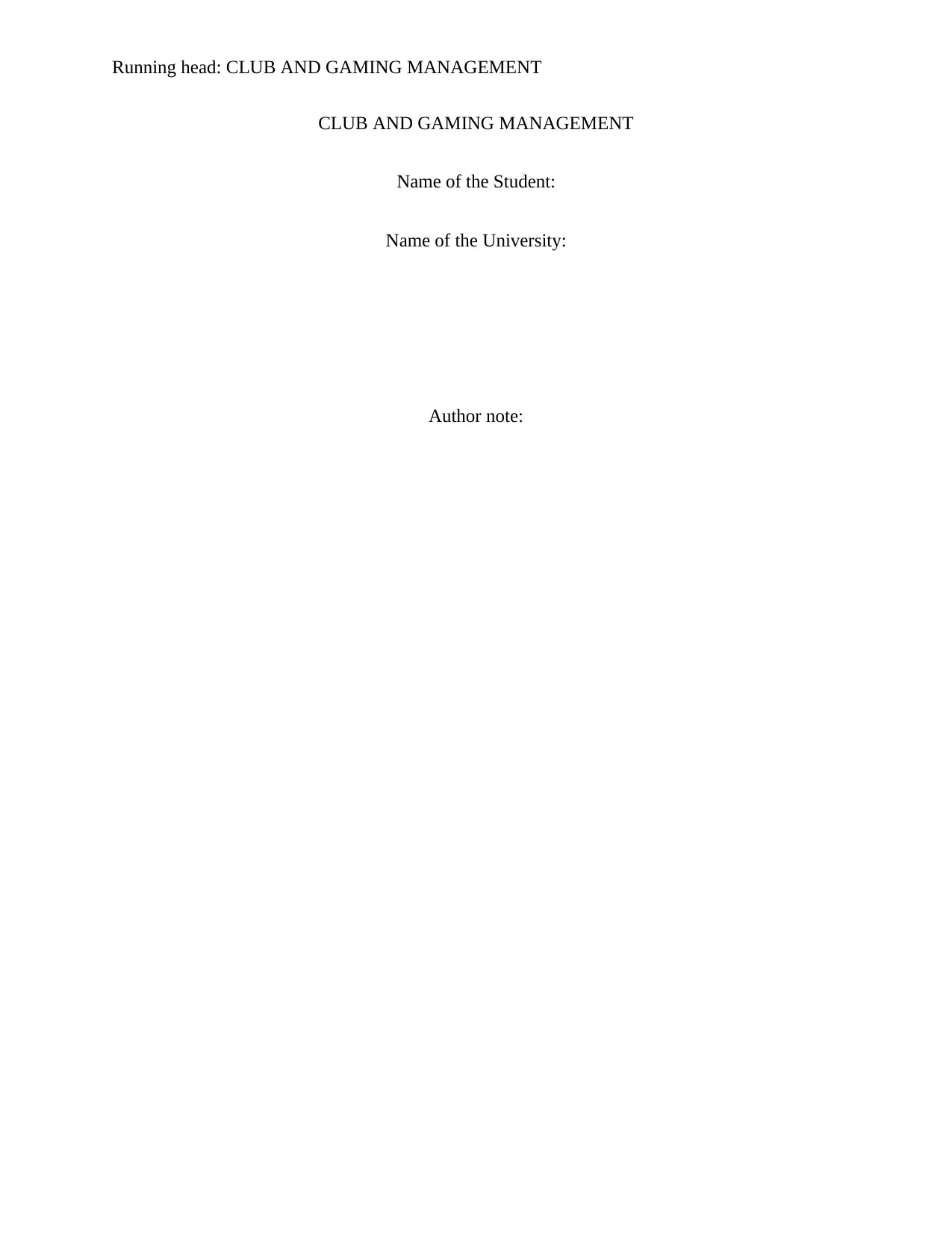
Running head: CLUB AND GAMING MANAGEMENT
CLUB AND GAMING MANAGEMENT
Name of the Student:
Name of the University:
Author note:
CLUB AND GAMING MANAGEMENT
Name of the Student:
Name of the University:
Author note:
Secure Best Marks with AI Grader
Need help grading? Try our AI Grader for instant feedback on your assignments.
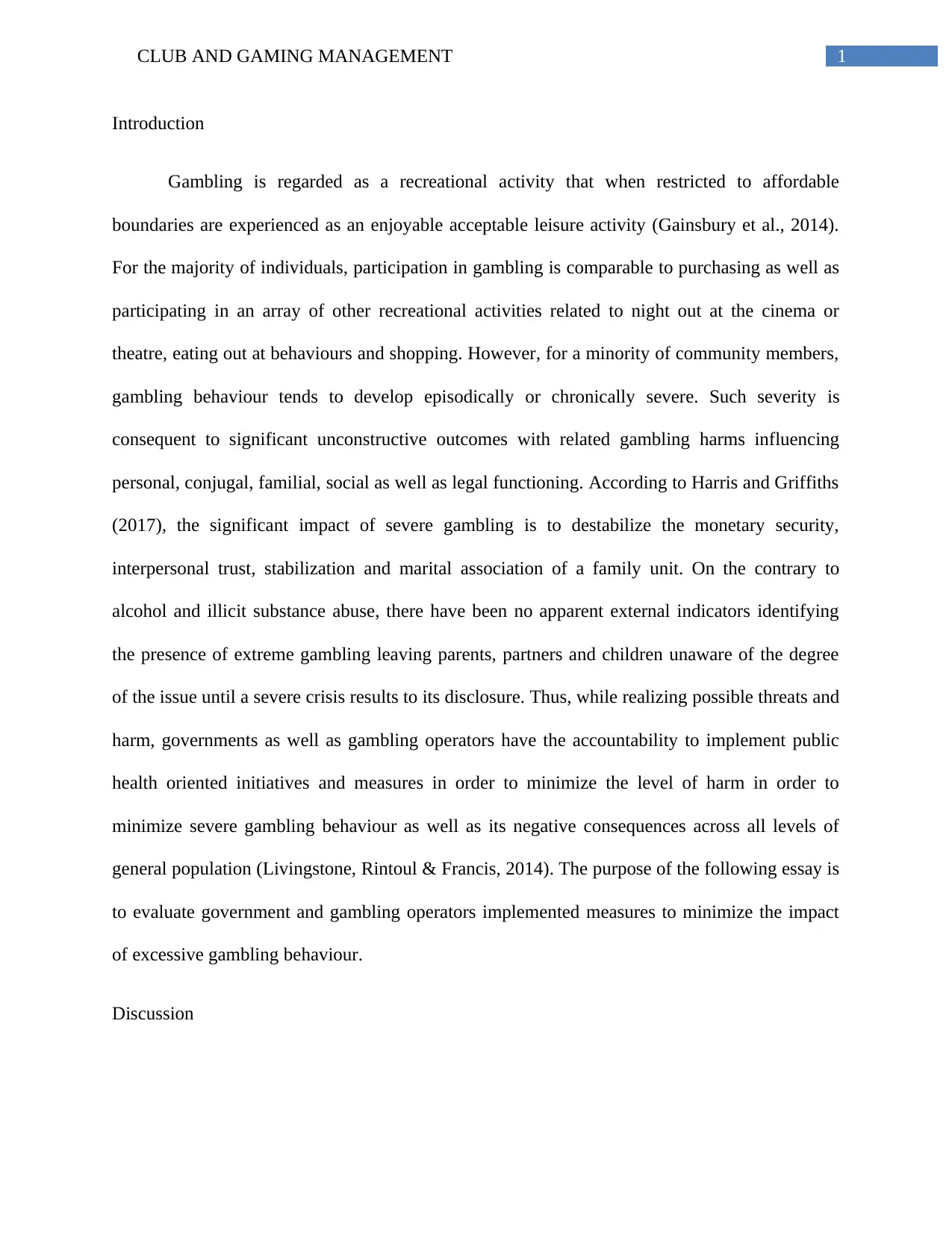
1CLUB AND GAMING MANAGEMENT
Introduction
Gambling is regarded as a recreational activity that when restricted to affordable
boundaries are experienced as an enjoyable acceptable leisure activity (Gainsbury et al., 2014).
For the majority of individuals, participation in gambling is comparable to purchasing as well as
participating in an array of other recreational activities related to night out at the cinema or
theatre, eating out at behaviours and shopping. However, for a minority of community members,
gambling behaviour tends to develop episodically or chronically severe. Such severity is
consequent to significant unconstructive outcomes with related gambling harms influencing
personal, conjugal, familial, social as well as legal functioning. According to Harris and Griffiths
(2017), the significant impact of severe gambling is to destabilize the monetary security,
interpersonal trust, stabilization and marital association of a family unit. On the contrary to
alcohol and illicit substance abuse, there have been no apparent external indicators identifying
the presence of extreme gambling leaving parents, partners and children unaware of the degree
of the issue until a severe crisis results to its disclosure. Thus, while realizing possible threats and
harm, governments as well as gambling operators have the accountability to implement public
health oriented initiatives and measures in order to minimize the level of harm in order to
minimize severe gambling behaviour as well as its negative consequences across all levels of
general population (Livingstone, Rintoul & Francis, 2014). The purpose of the following essay is
to evaluate government and gambling operators implemented measures to minimize the impact
of excessive gambling behaviour.
Discussion
Introduction
Gambling is regarded as a recreational activity that when restricted to affordable
boundaries are experienced as an enjoyable acceptable leisure activity (Gainsbury et al., 2014).
For the majority of individuals, participation in gambling is comparable to purchasing as well as
participating in an array of other recreational activities related to night out at the cinema or
theatre, eating out at behaviours and shopping. However, for a minority of community members,
gambling behaviour tends to develop episodically or chronically severe. Such severity is
consequent to significant unconstructive outcomes with related gambling harms influencing
personal, conjugal, familial, social as well as legal functioning. According to Harris and Griffiths
(2017), the significant impact of severe gambling is to destabilize the monetary security,
interpersonal trust, stabilization and marital association of a family unit. On the contrary to
alcohol and illicit substance abuse, there have been no apparent external indicators identifying
the presence of extreme gambling leaving parents, partners and children unaware of the degree
of the issue until a severe crisis results to its disclosure. Thus, while realizing possible threats and
harm, governments as well as gambling operators have the accountability to implement public
health oriented initiatives and measures in order to minimize the level of harm in order to
minimize severe gambling behaviour as well as its negative consequences across all levels of
general population (Livingstone, Rintoul & Francis, 2014). The purpose of the following essay is
to evaluate government and gambling operators implemented measures to minimize the impact
of excessive gambling behaviour.
Discussion
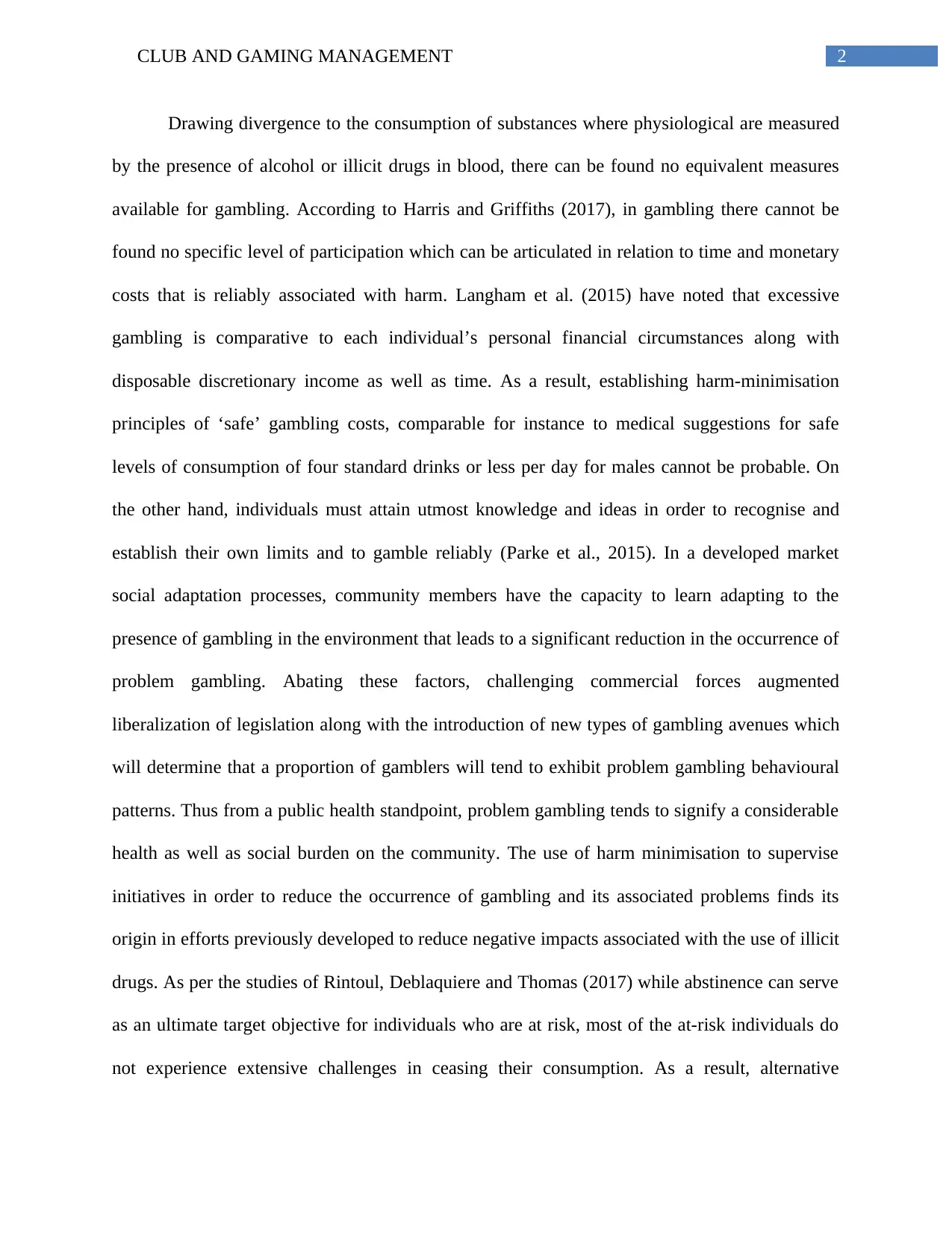
2CLUB AND GAMING MANAGEMENT
Drawing divergence to the consumption of substances where physiological are measured
by the presence of alcohol or illicit drugs in blood, there can be found no equivalent measures
available for gambling. According to Harris and Griffiths (2017), in gambling there cannot be
found no specific level of participation which can be articulated in relation to time and monetary
costs that is reliably associated with harm. Langham et al. (2015) have noted that excessive
gambling is comparative to each individual’s personal financial circumstances along with
disposable discretionary income as well as time. As a result, establishing harm-minimisation
principles of ‘safe’ gambling costs, comparable for instance to medical suggestions for safe
levels of consumption of four standard drinks or less per day for males cannot be probable. On
the other hand, individuals must attain utmost knowledge and ideas in order to recognise and
establish their own limits and to gamble reliably (Parke et al., 2015). In a developed market
social adaptation processes, community members have the capacity to learn adapting to the
presence of gambling in the environment that leads to a significant reduction in the occurrence of
problem gambling. Abating these factors, challenging commercial forces augmented
liberalization of legislation along with the introduction of new types of gambling avenues which
will determine that a proportion of gamblers will tend to exhibit problem gambling behavioural
patterns. Thus from a public health standpoint, problem gambling tends to signify a considerable
health as well as social burden on the community. The use of harm minimisation to supervise
initiatives in order to reduce the occurrence of gambling and its associated problems finds its
origin in efforts previously developed to reduce negative impacts associated with the use of illicit
drugs. As per the studies of Rintoul, Deblaquiere and Thomas (2017) while abstinence can serve
as an ultimate target objective for individuals who are at risk, most of the at-risk individuals do
not experience extensive challenges in ceasing their consumption. As a result, alternative
Drawing divergence to the consumption of substances where physiological are measured
by the presence of alcohol or illicit drugs in blood, there can be found no equivalent measures
available for gambling. According to Harris and Griffiths (2017), in gambling there cannot be
found no specific level of participation which can be articulated in relation to time and monetary
costs that is reliably associated with harm. Langham et al. (2015) have noted that excessive
gambling is comparative to each individual’s personal financial circumstances along with
disposable discretionary income as well as time. As a result, establishing harm-minimisation
principles of ‘safe’ gambling costs, comparable for instance to medical suggestions for safe
levels of consumption of four standard drinks or less per day for males cannot be probable. On
the other hand, individuals must attain utmost knowledge and ideas in order to recognise and
establish their own limits and to gamble reliably (Parke et al., 2015). In a developed market
social adaptation processes, community members have the capacity to learn adapting to the
presence of gambling in the environment that leads to a significant reduction in the occurrence of
problem gambling. Abating these factors, challenging commercial forces augmented
liberalization of legislation along with the introduction of new types of gambling avenues which
will determine that a proportion of gamblers will tend to exhibit problem gambling behavioural
patterns. Thus from a public health standpoint, problem gambling tends to signify a considerable
health as well as social burden on the community. The use of harm minimisation to supervise
initiatives in order to reduce the occurrence of gambling and its associated problems finds its
origin in efforts previously developed to reduce negative impacts associated with the use of illicit
drugs. As per the studies of Rintoul, Deblaquiere and Thomas (2017) while abstinence can serve
as an ultimate target objective for individuals who are at risk, most of the at-risk individuals do
not experience extensive challenges in ceasing their consumption. As a result, alternative
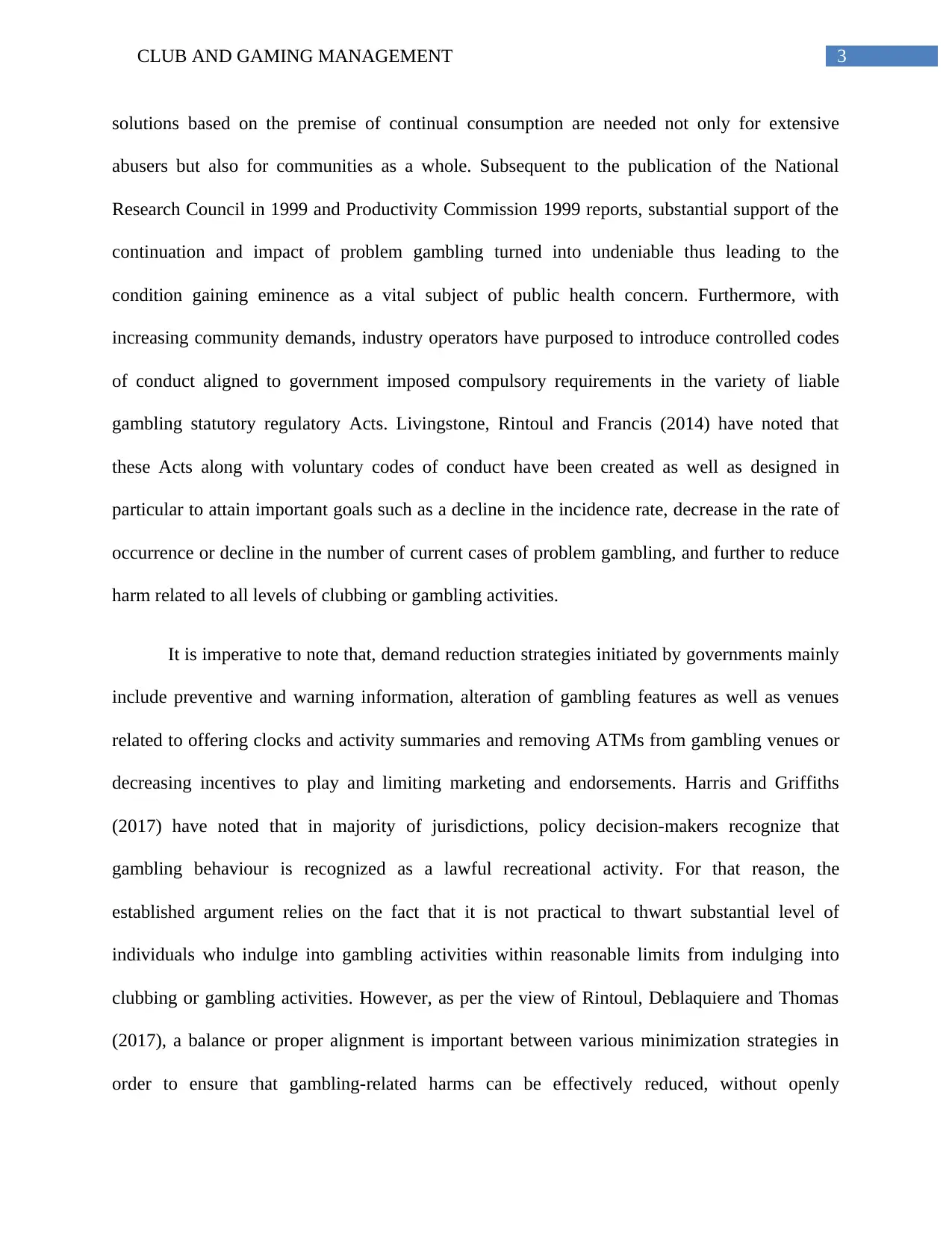
3CLUB AND GAMING MANAGEMENT
solutions based on the premise of continual consumption are needed not only for extensive
abusers but also for communities as a whole. Subsequent to the publication of the National
Research Council in 1999 and Productivity Commission 1999 reports, substantial support of the
continuation and impact of problem gambling turned into undeniable thus leading to the
condition gaining eminence as a vital subject of public health concern. Furthermore, with
increasing community demands, industry operators have purposed to introduce controlled codes
of conduct aligned to government imposed compulsory requirements in the variety of liable
gambling statutory regulatory Acts. Livingstone, Rintoul and Francis (2014) have noted that
these Acts along with voluntary codes of conduct have been created as well as designed in
particular to attain important goals such as a decline in the incidence rate, decrease in the rate of
occurrence or decline in the number of current cases of problem gambling, and further to reduce
harm related to all levels of clubbing or gambling activities.
It is imperative to note that, demand reduction strategies initiated by governments mainly
include preventive and warning information, alteration of gambling features as well as venues
related to offering clocks and activity summaries and removing ATMs from gambling venues or
decreasing incentives to play and limiting marketing and endorsements. Harris and Griffiths
(2017) have noted that in majority of jurisdictions, policy decision-makers recognize that
gambling behaviour is recognized as a lawful recreational activity. For that reason, the
established argument relies on the fact that it is not practical to thwart substantial level of
individuals who indulge into gambling activities within reasonable limits from indulging into
clubbing or gambling activities. However, as per the view of Rintoul, Deblaquiere and Thomas
(2017), a balance or proper alignment is important between various minimization strategies in
order to ensure that gambling-related harms can be effectively reduced, without openly
solutions based on the premise of continual consumption are needed not only for extensive
abusers but also for communities as a whole. Subsequent to the publication of the National
Research Council in 1999 and Productivity Commission 1999 reports, substantial support of the
continuation and impact of problem gambling turned into undeniable thus leading to the
condition gaining eminence as a vital subject of public health concern. Furthermore, with
increasing community demands, industry operators have purposed to introduce controlled codes
of conduct aligned to government imposed compulsory requirements in the variety of liable
gambling statutory regulatory Acts. Livingstone, Rintoul and Francis (2014) have noted that
these Acts along with voluntary codes of conduct have been created as well as designed in
particular to attain important goals such as a decline in the incidence rate, decrease in the rate of
occurrence or decline in the number of current cases of problem gambling, and further to reduce
harm related to all levels of clubbing or gambling activities.
It is imperative to note that, demand reduction strategies initiated by governments mainly
include preventive and warning information, alteration of gambling features as well as venues
related to offering clocks and activity summaries and removing ATMs from gambling venues or
decreasing incentives to play and limiting marketing and endorsements. Harris and Griffiths
(2017) have noted that in majority of jurisdictions, policy decision-makers recognize that
gambling behaviour is recognized as a lawful recreational activity. For that reason, the
established argument relies on the fact that it is not practical to thwart substantial level of
individuals who indulge into gambling activities within reasonable limits from indulging into
clubbing or gambling activities. However, as per the view of Rintoul, Deblaquiere and Thomas
(2017), a balance or proper alignment is important between various minimization strategies in
order to ensure that gambling-related harms can be effectively reduced, without openly
Secure Best Marks with AI Grader
Need help grading? Try our AI Grader for instant feedback on your assignments.
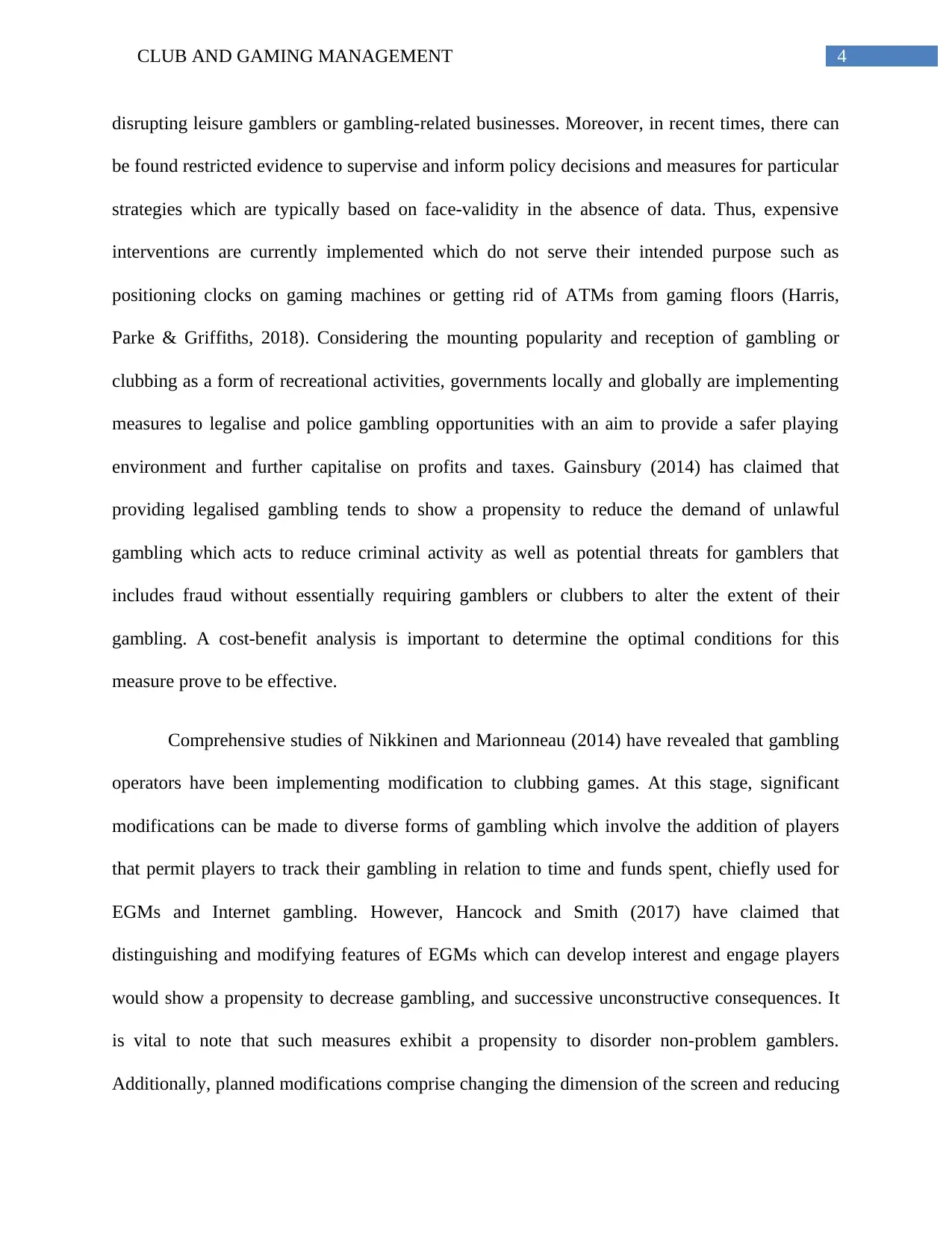
4CLUB AND GAMING MANAGEMENT
disrupting leisure gamblers or gambling-related businesses. Moreover, in recent times, there can
be found restricted evidence to supervise and inform policy decisions and measures for particular
strategies which are typically based on face-validity in the absence of data. Thus, expensive
interventions are currently implemented which do not serve their intended purpose such as
positioning clocks on gaming machines or getting rid of ATMs from gaming floors (Harris,
Parke & Griffiths, 2018). Considering the mounting popularity and reception of gambling or
clubbing as a form of recreational activities, governments locally and globally are implementing
measures to legalise and police gambling opportunities with an aim to provide a safer playing
environment and further capitalise on profits and taxes. Gainsbury (2014) has claimed that
providing legalised gambling tends to show a propensity to reduce the demand of unlawful
gambling which acts to reduce criminal activity as well as potential threats for gamblers that
includes fraud without essentially requiring gamblers or clubbers to alter the extent of their
gambling. A cost-benefit analysis is important to determine the optimal conditions for this
measure prove to be effective.
Comprehensive studies of Nikkinen and Marionneau (2014) have revealed that gambling
operators have been implementing modification to clubbing games. At this stage, significant
modifications can be made to diverse forms of gambling which involve the addition of players
that permit players to track their gambling in relation to time and funds spent, chiefly used for
EGMs and Internet gambling. However, Hancock and Smith (2017) have claimed that
distinguishing and modifying features of EGMs which can develop interest and engage players
would show a propensity to decrease gambling, and successive unconstructive consequences. It
is vital to note that such measures exhibit a propensity to disorder non-problem gamblers.
Additionally, planned modifications comprise changing the dimension of the screen and reducing
disrupting leisure gamblers or gambling-related businesses. Moreover, in recent times, there can
be found restricted evidence to supervise and inform policy decisions and measures for particular
strategies which are typically based on face-validity in the absence of data. Thus, expensive
interventions are currently implemented which do not serve their intended purpose such as
positioning clocks on gaming machines or getting rid of ATMs from gaming floors (Harris,
Parke & Griffiths, 2018). Considering the mounting popularity and reception of gambling or
clubbing as a form of recreational activities, governments locally and globally are implementing
measures to legalise and police gambling opportunities with an aim to provide a safer playing
environment and further capitalise on profits and taxes. Gainsbury (2014) has claimed that
providing legalised gambling tends to show a propensity to reduce the demand of unlawful
gambling which acts to reduce criminal activity as well as potential threats for gamblers that
includes fraud without essentially requiring gamblers or clubbers to alter the extent of their
gambling. A cost-benefit analysis is important to determine the optimal conditions for this
measure prove to be effective.
Comprehensive studies of Nikkinen and Marionneau (2014) have revealed that gambling
operators have been implementing modification to clubbing games. At this stage, significant
modifications can be made to diverse forms of gambling which involve the addition of players
that permit players to track their gambling in relation to time and funds spent, chiefly used for
EGMs and Internet gambling. However, Hancock and Smith (2017) have claimed that
distinguishing and modifying features of EGMs which can develop interest and engage players
would show a propensity to decrease gambling, and successive unconstructive consequences. It
is vital to note that such measures exhibit a propensity to disorder non-problem gamblers.
Additionally, planned modifications comprise changing the dimension of the screen and reducing
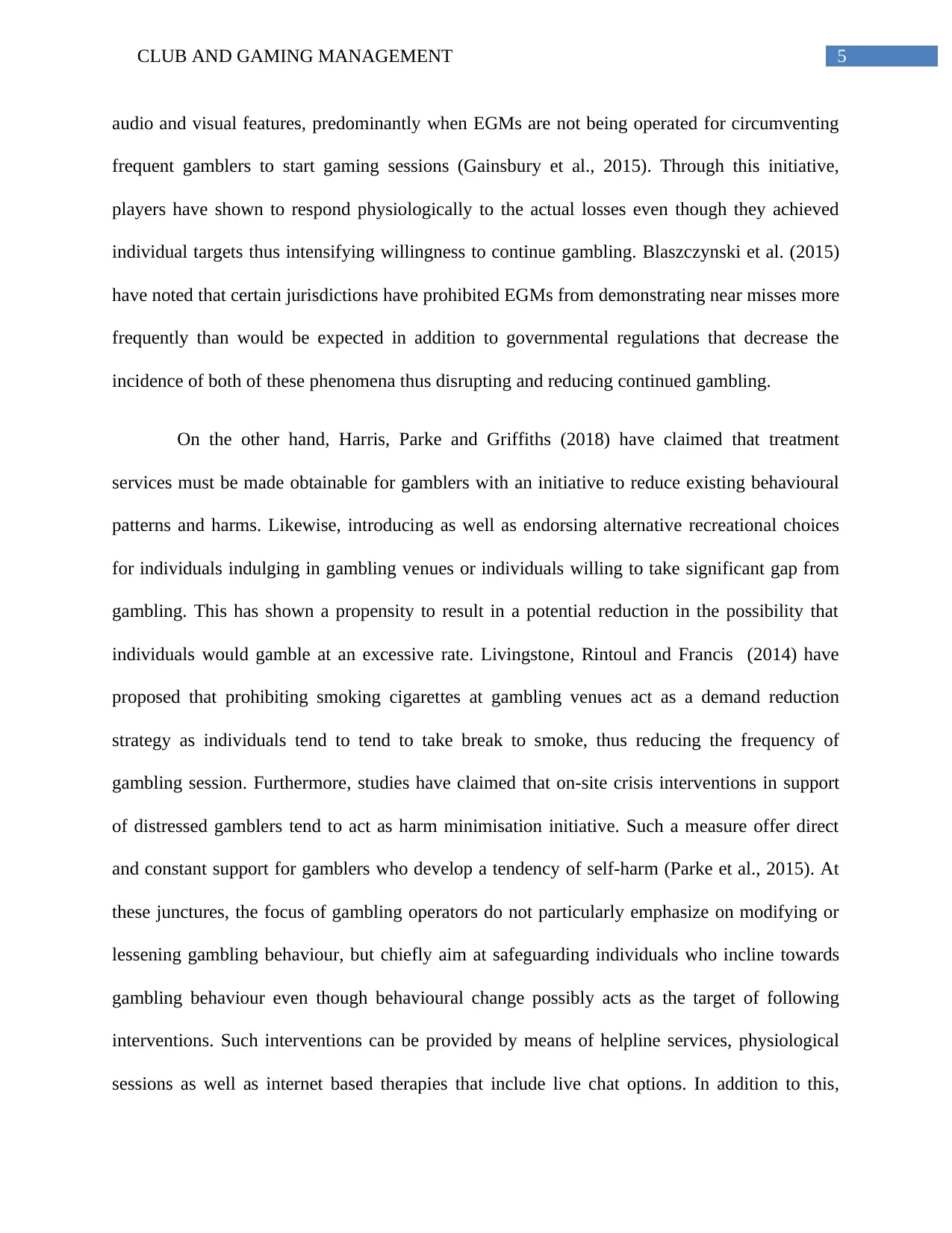
5CLUB AND GAMING MANAGEMENT
audio and visual features, predominantly when EGMs are not being operated for circumventing
frequent gamblers to start gaming sessions (Gainsbury et al., 2015). Through this initiative,
players have shown to respond physiologically to the actual losses even though they achieved
individual targets thus intensifying willingness to continue gambling. Blaszczynski et al. (2015)
have noted that certain jurisdictions have prohibited EGMs from demonstrating near misses more
frequently than would be expected in addition to governmental regulations that decrease the
incidence of both of these phenomena thus disrupting and reducing continued gambling.
On the other hand, Harris, Parke and Griffiths (2018) have claimed that treatment
services must be made obtainable for gamblers with an initiative to reduce existing behavioural
patterns and harms. Likewise, introducing as well as endorsing alternative recreational choices
for individuals indulging in gambling venues or individuals willing to take significant gap from
gambling. This has shown a propensity to result in a potential reduction in the possibility that
individuals would gamble at an excessive rate. Livingstone, Rintoul and Francis (2014) have
proposed that prohibiting smoking cigarettes at gambling venues act as a demand reduction
strategy as individuals tend to tend to take break to smoke, thus reducing the frequency of
gambling session. Furthermore, studies have claimed that on-site crisis interventions in support
of distressed gamblers tend to act as harm minimisation initiative. Such a measure offer direct
and constant support for gamblers who develop a tendency of self-harm (Parke et al., 2015). At
these junctures, the focus of gambling operators do not particularly emphasize on modifying or
lessening gambling behaviour, but chiefly aim at safeguarding individuals who incline towards
gambling behaviour even though behavioural change possibly acts as the target of following
interventions. Such interventions can be provided by means of helpline services, physiological
sessions as well as internet based therapies that include live chat options. In addition to this,
audio and visual features, predominantly when EGMs are not being operated for circumventing
frequent gamblers to start gaming sessions (Gainsbury et al., 2015). Through this initiative,
players have shown to respond physiologically to the actual losses even though they achieved
individual targets thus intensifying willingness to continue gambling. Blaszczynski et al. (2015)
have noted that certain jurisdictions have prohibited EGMs from demonstrating near misses more
frequently than would be expected in addition to governmental regulations that decrease the
incidence of both of these phenomena thus disrupting and reducing continued gambling.
On the other hand, Harris, Parke and Griffiths (2018) have claimed that treatment
services must be made obtainable for gamblers with an initiative to reduce existing behavioural
patterns and harms. Likewise, introducing as well as endorsing alternative recreational choices
for individuals indulging in gambling venues or individuals willing to take significant gap from
gambling. This has shown a propensity to result in a potential reduction in the possibility that
individuals would gamble at an excessive rate. Livingstone, Rintoul and Francis (2014) have
proposed that prohibiting smoking cigarettes at gambling venues act as a demand reduction
strategy as individuals tend to tend to take break to smoke, thus reducing the frequency of
gambling session. Furthermore, studies have claimed that on-site crisis interventions in support
of distressed gamblers tend to act as harm minimisation initiative. Such a measure offer direct
and constant support for gamblers who develop a tendency of self-harm (Parke et al., 2015). At
these junctures, the focus of gambling operators do not particularly emphasize on modifying or
lessening gambling behaviour, but chiefly aim at safeguarding individuals who incline towards
gambling behaviour even though behavioural change possibly acts as the target of following
interventions. Such interventions can be provided by means of helpline services, physiological
sessions as well as internet based therapies that include live chat options. In addition to this,
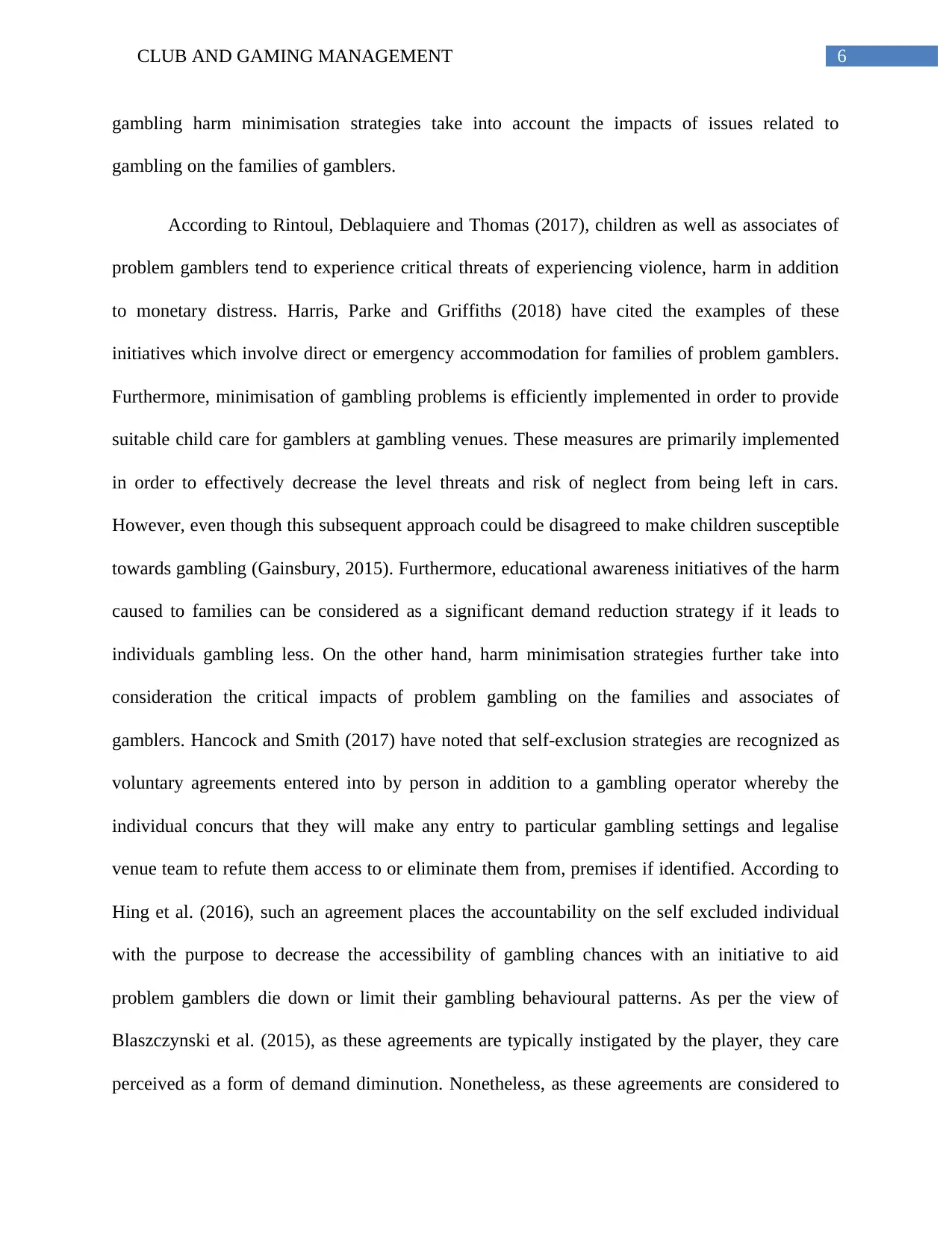
6CLUB AND GAMING MANAGEMENT
gambling harm minimisation strategies take into account the impacts of issues related to
gambling on the families of gamblers.
According to Rintoul, Deblaquiere and Thomas (2017), children as well as associates of
problem gamblers tend to experience critical threats of experiencing violence, harm in addition
to monetary distress. Harris, Parke and Griffiths (2018) have cited the examples of these
initiatives which involve direct or emergency accommodation for families of problem gamblers.
Furthermore, minimisation of gambling problems is efficiently implemented in order to provide
suitable child care for gamblers at gambling venues. These measures are primarily implemented
in order to effectively decrease the level threats and risk of neglect from being left in cars.
However, even though this subsequent approach could be disagreed to make children susceptible
towards gambling (Gainsbury, 2015). Furthermore, educational awareness initiatives of the harm
caused to families can be considered as a significant demand reduction strategy if it leads to
individuals gambling less. On the other hand, harm minimisation strategies further take into
consideration the critical impacts of problem gambling on the families and associates of
gamblers. Hancock and Smith (2017) have noted that self-exclusion strategies are recognized as
voluntary agreements entered into by person in addition to a gambling operator whereby the
individual concurs that they will make any entry to particular gambling settings and legalise
venue team to refute them access to or eliminate them from, premises if identified. According to
Hing et al. (2016), such an agreement places the accountability on the self excluded individual
with the purpose to decrease the accessibility of gambling chances with an initiative to aid
problem gamblers die down or limit their gambling behavioural patterns. As per the view of
Blaszczynski et al. (2015), as these agreements are typically instigated by the player, they care
perceived as a form of demand diminution. Nonetheless, as these agreements are considered to
gambling harm minimisation strategies take into account the impacts of issues related to
gambling on the families of gamblers.
According to Rintoul, Deblaquiere and Thomas (2017), children as well as associates of
problem gamblers tend to experience critical threats of experiencing violence, harm in addition
to monetary distress. Harris, Parke and Griffiths (2018) have cited the examples of these
initiatives which involve direct or emergency accommodation for families of problem gamblers.
Furthermore, minimisation of gambling problems is efficiently implemented in order to provide
suitable child care for gamblers at gambling venues. These measures are primarily implemented
in order to effectively decrease the level threats and risk of neglect from being left in cars.
However, even though this subsequent approach could be disagreed to make children susceptible
towards gambling (Gainsbury, 2015). Furthermore, educational awareness initiatives of the harm
caused to families can be considered as a significant demand reduction strategy if it leads to
individuals gambling less. On the other hand, harm minimisation strategies further take into
consideration the critical impacts of problem gambling on the families and associates of
gamblers. Hancock and Smith (2017) have noted that self-exclusion strategies are recognized as
voluntary agreements entered into by person in addition to a gambling operator whereby the
individual concurs that they will make any entry to particular gambling settings and legalise
venue team to refute them access to or eliminate them from, premises if identified. According to
Hing et al. (2016), such an agreement places the accountability on the self excluded individual
with the purpose to decrease the accessibility of gambling chances with an initiative to aid
problem gamblers die down or limit their gambling behavioural patterns. As per the view of
Blaszczynski et al. (2015), as these agreements are typically instigated by the player, they care
perceived as a form of demand diminution. Nonetheless, as these agreements are considered to
Paraphrase This Document
Need a fresh take? Get an instant paraphrase of this document with our AI Paraphraser
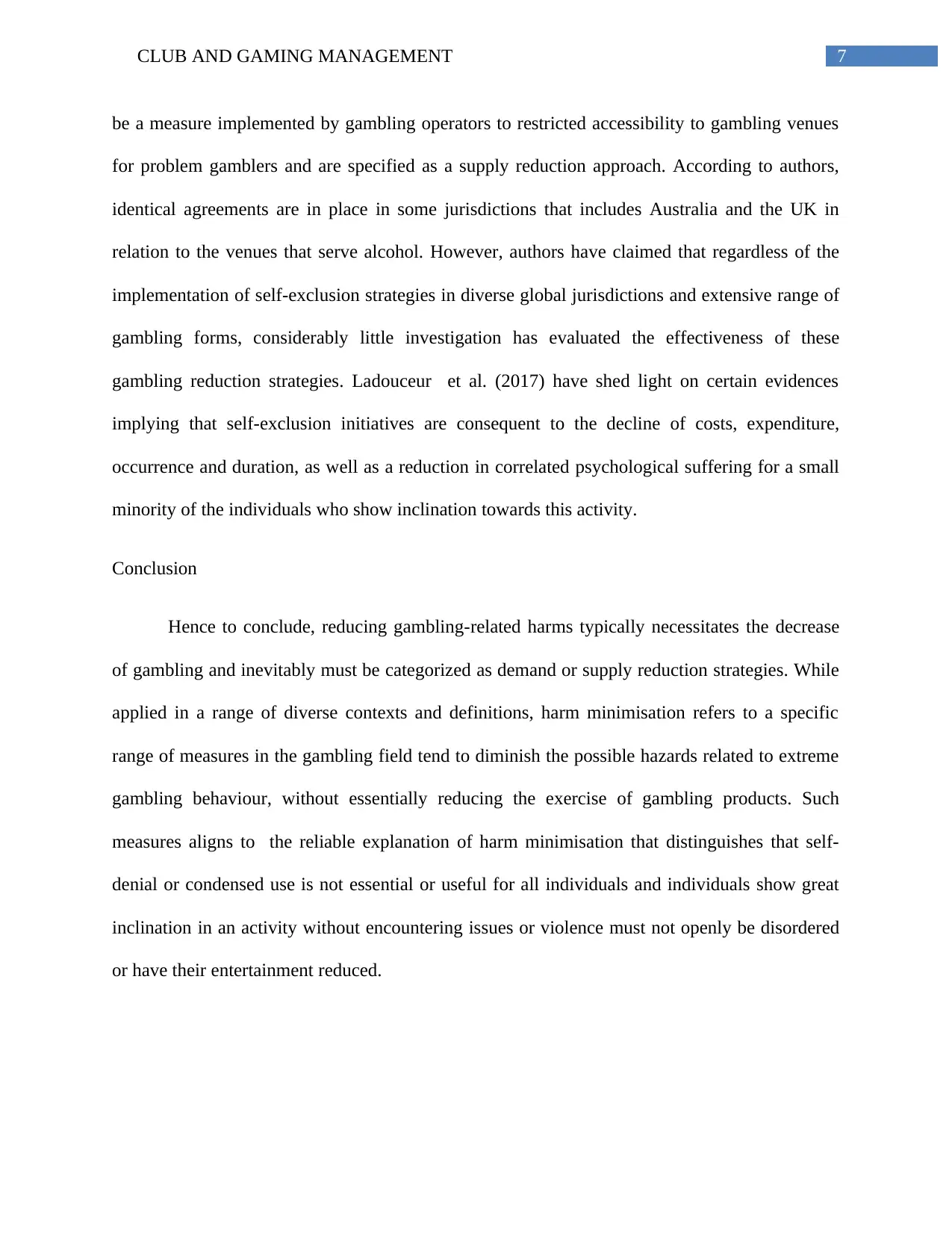
7CLUB AND GAMING MANAGEMENT
be a measure implemented by gambling operators to restricted accessibility to gambling venues
for problem gamblers and are specified as a supply reduction approach. According to authors,
identical agreements are in place in some jurisdictions that includes Australia and the UK in
relation to the venues that serve alcohol. However, authors have claimed that regardless of the
implementation of self-exclusion strategies in diverse global jurisdictions and extensive range of
gambling forms, considerably little investigation has evaluated the effectiveness of these
gambling reduction strategies. Ladouceur et al. (2017) have shed light on certain evidences
implying that self-exclusion initiatives are consequent to the decline of costs, expenditure,
occurrence and duration, as well as a reduction in correlated psychological suffering for a small
minority of the individuals who show inclination towards this activity.
Conclusion
Hence to conclude, reducing gambling-related harms typically necessitates the decrease
of gambling and inevitably must be categorized as demand or supply reduction strategies. While
applied in a range of diverse contexts and definitions, harm minimisation refers to a specific
range of measures in the gambling field tend to diminish the possible hazards related to extreme
gambling behaviour, without essentially reducing the exercise of gambling products. Such
measures aligns to the reliable explanation of harm minimisation that distinguishes that self-
denial or condensed use is not essential or useful for all individuals and individuals show great
inclination in an activity without encountering issues or violence must not openly be disordered
or have their entertainment reduced.
be a measure implemented by gambling operators to restricted accessibility to gambling venues
for problem gamblers and are specified as a supply reduction approach. According to authors,
identical agreements are in place in some jurisdictions that includes Australia and the UK in
relation to the venues that serve alcohol. However, authors have claimed that regardless of the
implementation of self-exclusion strategies in diverse global jurisdictions and extensive range of
gambling forms, considerably little investigation has evaluated the effectiveness of these
gambling reduction strategies. Ladouceur et al. (2017) have shed light on certain evidences
implying that self-exclusion initiatives are consequent to the decline of costs, expenditure,
occurrence and duration, as well as a reduction in correlated psychological suffering for a small
minority of the individuals who show inclination towards this activity.
Conclusion
Hence to conclude, reducing gambling-related harms typically necessitates the decrease
of gambling and inevitably must be categorized as demand or supply reduction strategies. While
applied in a range of diverse contexts and definitions, harm minimisation refers to a specific
range of measures in the gambling field tend to diminish the possible hazards related to extreme
gambling behaviour, without essentially reducing the exercise of gambling products. Such
measures aligns to the reliable explanation of harm minimisation that distinguishes that self-
denial or condensed use is not essential or useful for all individuals and individuals show great
inclination in an activity without encountering issues or violence must not openly be disordered
or have their entertainment reduced.
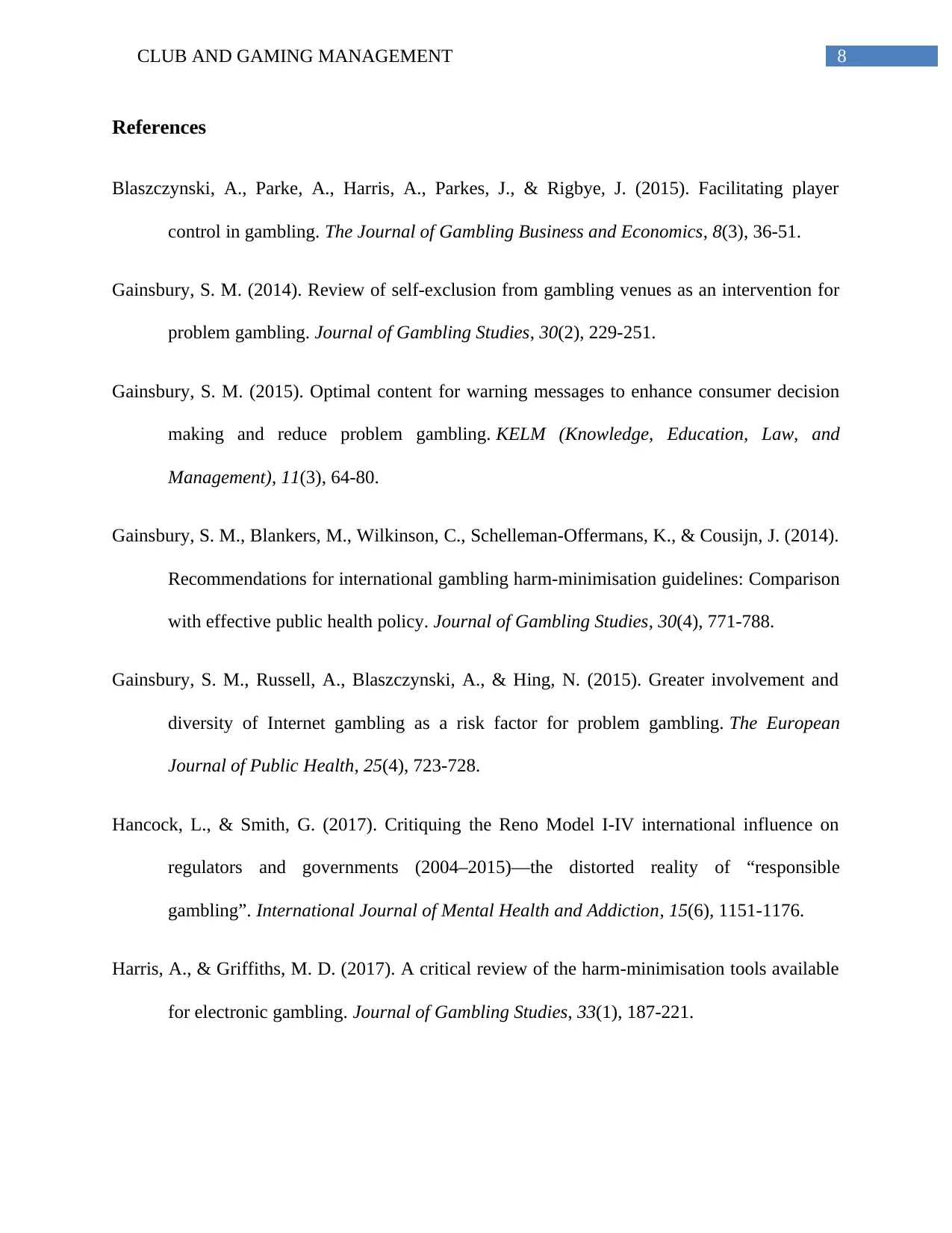
8CLUB AND GAMING MANAGEMENT
References
Blaszczynski, A., Parke, A., Harris, A., Parkes, J., & Rigbye, J. (2015). Facilitating player
control in gambling. The Journal of Gambling Business and Economics, 8(3), 36-51.
Gainsbury, S. M. (2014). Review of self-exclusion from gambling venues as an intervention for
problem gambling. Journal of Gambling Studies, 30(2), 229-251.
Gainsbury, S. M. (2015). Optimal content for warning messages to enhance consumer decision
making and reduce problem gambling. KELM (Knowledge, Education, Law, and
Management), 11(3), 64-80.
Gainsbury, S. M., Blankers, M., Wilkinson, C., Schelleman-Offermans, K., & Cousijn, J. (2014).
Recommendations for international gambling harm-minimisation guidelines: Comparison
with effective public health policy. Journal of Gambling Studies, 30(4), 771-788.
Gainsbury, S. M., Russell, A., Blaszczynski, A., & Hing, N. (2015). Greater involvement and
diversity of Internet gambling as a risk factor for problem gambling. The European
Journal of Public Health, 25(4), 723-728.
Hancock, L., & Smith, G. (2017). Critiquing the Reno Model I-IV international influence on
regulators and governments (2004–2015)—the distorted reality of “responsible
gambling”. International Journal of Mental Health and Addiction, 15(6), 1151-1176.
Harris, A., & Griffiths, M. D. (2017). A critical review of the harm-minimisation tools available
for electronic gambling. Journal of Gambling Studies, 33(1), 187-221.
References
Blaszczynski, A., Parke, A., Harris, A., Parkes, J., & Rigbye, J. (2015). Facilitating player
control in gambling. The Journal of Gambling Business and Economics, 8(3), 36-51.
Gainsbury, S. M. (2014). Review of self-exclusion from gambling venues as an intervention for
problem gambling. Journal of Gambling Studies, 30(2), 229-251.
Gainsbury, S. M. (2015). Optimal content for warning messages to enhance consumer decision
making and reduce problem gambling. KELM (Knowledge, Education, Law, and
Management), 11(3), 64-80.
Gainsbury, S. M., Blankers, M., Wilkinson, C., Schelleman-Offermans, K., & Cousijn, J. (2014).
Recommendations for international gambling harm-minimisation guidelines: Comparison
with effective public health policy. Journal of Gambling Studies, 30(4), 771-788.
Gainsbury, S. M., Russell, A., Blaszczynski, A., & Hing, N. (2015). Greater involvement and
diversity of Internet gambling as a risk factor for problem gambling. The European
Journal of Public Health, 25(4), 723-728.
Hancock, L., & Smith, G. (2017). Critiquing the Reno Model I-IV international influence on
regulators and governments (2004–2015)—the distorted reality of “responsible
gambling”. International Journal of Mental Health and Addiction, 15(6), 1151-1176.
Harris, A., & Griffiths, M. D. (2017). A critical review of the harm-minimisation tools available
for electronic gambling. Journal of Gambling Studies, 33(1), 187-221.
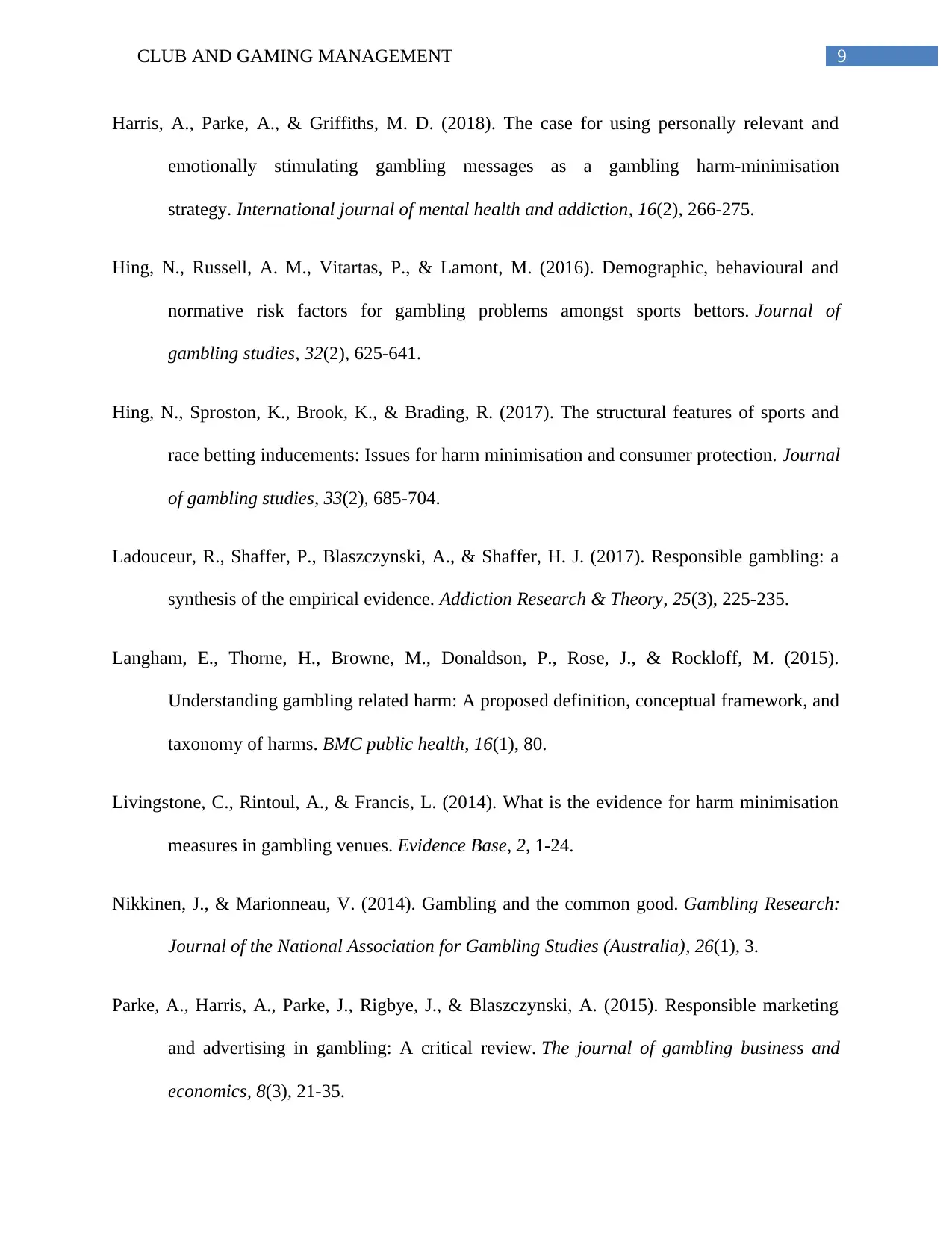
9CLUB AND GAMING MANAGEMENT
Harris, A., Parke, A., & Griffiths, M. D. (2018). The case for using personally relevant and
emotionally stimulating gambling messages as a gambling harm-minimisation
strategy. International journal of mental health and addiction, 16(2), 266-275.
Hing, N., Russell, A. M., Vitartas, P., & Lamont, M. (2016). Demographic, behavioural and
normative risk factors for gambling problems amongst sports bettors. Journal of
gambling studies, 32(2), 625-641.
Hing, N., Sproston, K., Brook, K., & Brading, R. (2017). The structural features of sports and
race betting inducements: Issues for harm minimisation and consumer protection. Journal
of gambling studies, 33(2), 685-704.
Ladouceur, R., Shaffer, P., Blaszczynski, A., & Shaffer, H. J. (2017). Responsible gambling: a
synthesis of the empirical evidence. Addiction Research & Theory, 25(3), 225-235.
Langham, E., Thorne, H., Browne, M., Donaldson, P., Rose, J., & Rockloff, M. (2015).
Understanding gambling related harm: A proposed definition, conceptual framework, and
taxonomy of harms. BMC public health, 16(1), 80.
Livingstone, C., Rintoul, A., & Francis, L. (2014). What is the evidence for harm minimisation
measures in gambling venues. Evidence Base, 2, 1-24.
Nikkinen, J., & Marionneau, V. (2014). Gambling and the common good. Gambling Research:
Journal of the National Association for Gambling Studies (Australia), 26(1), 3.
Parke, A., Harris, A., Parke, J., Rigbye, J., & Blaszczynski, A. (2015). Responsible marketing
and advertising in gambling: A critical review. The journal of gambling business and
economics, 8(3), 21-35.
Harris, A., Parke, A., & Griffiths, M. D. (2018). The case for using personally relevant and
emotionally stimulating gambling messages as a gambling harm-minimisation
strategy. International journal of mental health and addiction, 16(2), 266-275.
Hing, N., Russell, A. M., Vitartas, P., & Lamont, M. (2016). Demographic, behavioural and
normative risk factors for gambling problems amongst sports bettors. Journal of
gambling studies, 32(2), 625-641.
Hing, N., Sproston, K., Brook, K., & Brading, R. (2017). The structural features of sports and
race betting inducements: Issues for harm minimisation and consumer protection. Journal
of gambling studies, 33(2), 685-704.
Ladouceur, R., Shaffer, P., Blaszczynski, A., & Shaffer, H. J. (2017). Responsible gambling: a
synthesis of the empirical evidence. Addiction Research & Theory, 25(3), 225-235.
Langham, E., Thorne, H., Browne, M., Donaldson, P., Rose, J., & Rockloff, M. (2015).
Understanding gambling related harm: A proposed definition, conceptual framework, and
taxonomy of harms. BMC public health, 16(1), 80.
Livingstone, C., Rintoul, A., & Francis, L. (2014). What is the evidence for harm minimisation
measures in gambling venues. Evidence Base, 2, 1-24.
Nikkinen, J., & Marionneau, V. (2014). Gambling and the common good. Gambling Research:
Journal of the National Association for Gambling Studies (Australia), 26(1), 3.
Parke, A., Harris, A., Parke, J., Rigbye, J., & Blaszczynski, A. (2015). Responsible marketing
and advertising in gambling: A critical review. The journal of gambling business and
economics, 8(3), 21-35.
Secure Best Marks with AI Grader
Need help grading? Try our AI Grader for instant feedback on your assignments.
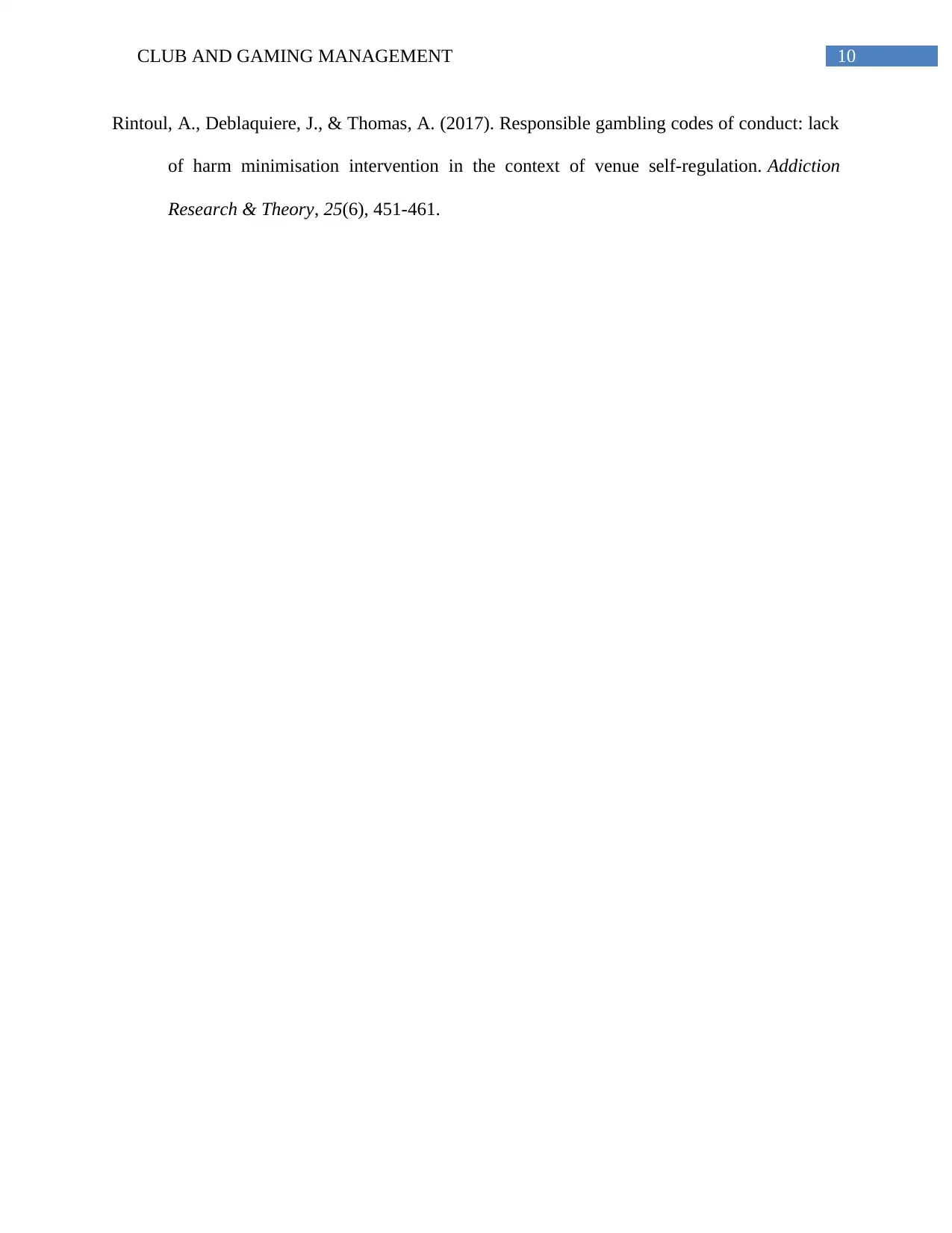
10CLUB AND GAMING MANAGEMENT
Rintoul, A., Deblaquiere, J., & Thomas, A. (2017). Responsible gambling codes of conduct: lack
of harm minimisation intervention in the context of venue self-regulation. Addiction
Research & Theory, 25(6), 451-461.
Rintoul, A., Deblaquiere, J., & Thomas, A. (2017). Responsible gambling codes of conduct: lack
of harm minimisation intervention in the context of venue self-regulation. Addiction
Research & Theory, 25(6), 451-461.
1 out of 11
Related Documents
Your All-in-One AI-Powered Toolkit for Academic Success.
+13062052269
info@desklib.com
Available 24*7 on WhatsApp / Email
![[object Object]](/_next/static/media/star-bottom.7253800d.svg)
Unlock your academic potential
© 2024 | Zucol Services PVT LTD | All rights reserved.
